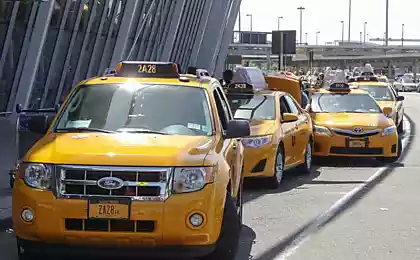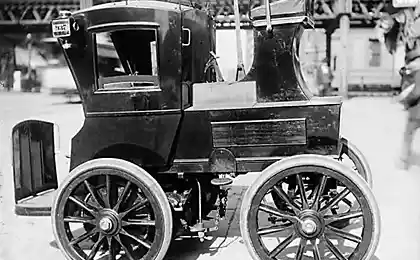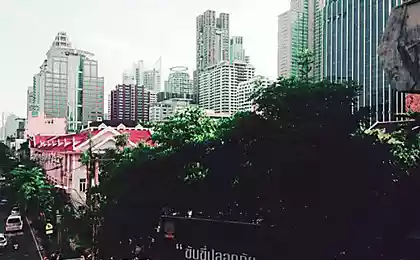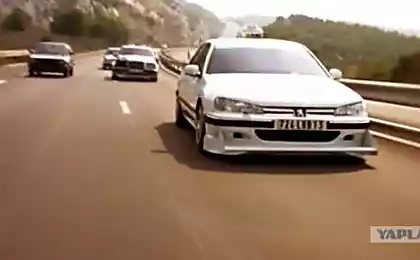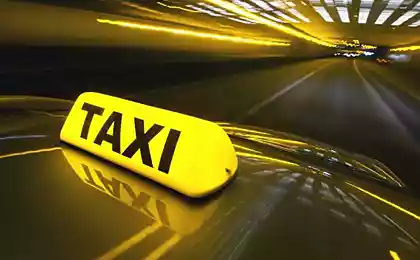932
History Taxi
Historians of Great Britain and France still dispute the palm in question, which of these countries should be considered as the progenitor of a taxi.
Both are right.
Passenger carting, as such, of course, originated in Britain (remember the famous London gig - cabs), France, meanwhile, became the founder of the modern taxi car, as it is here were laid to create a recognizable tradition and to this day the canons of this business.

The precursors of automobile taxi - horse-drawn carriages (cabs and fiacres)
So, the first organized paid transportation of passengers in the settlements began to be carried out in the UK in the XVII century. In 1639 the corporation was established kouchmenov license carting. First, the crews were quite bulky, and four open - they were called Hackney (hackney - a traveling horse). In winter, some particularly careful driver pulled over tilt carts.

In the middle of the eighteenth century, the private carting appeared in France, where some enterprising Frenchman founded inn horse-drawn carriages. Almost all of these carts had a closed body, and equipped with three rows of seats, where passengers are arranged facing each other (sometimes - in the direction of motion) and on a separate front seat sat the driver. Such carts - fiacres - became the world's first many-hired public crews. Prior to this in Europe capacious carriages belonged only to the nobles and landowners.
In the XIX century (1840-1845 gg.), London introduced into use more agile two-wheeled open carriage - convertible, abbreviated - cab. Subsequently, there were two and three cabs with a closed cab, and the driver's workplace has moved backwards and upwards, where it was easier to see the house numbers when there reigned the famous English fog. The British are known for their traditionalism, abandoned horse-drawn carriages - cabs, only in the middle of the XX century. Of course, a taxi car had already been actively developed in the UK, but in London the last horse cabby had surrendered his license only in 1947.

Beginning era taxis
In 1896, the French automobile club has proclaimed that the "capital of the world" would be very to face motorized fiacres - without horses. It Said - done: with Fiacre removed shafts, have established behind the petrol engine and near the driver's seat - the steering column and steering gear. At first, the idea was not successful, because they could not decide which tariff to pay travel and work drivers, and the piece made machines were expensive. Invented in 1905 by Count - taximeter - to a certain extent calmed disputes. From it came the name of the new mode of transport - taxis or taxi.

The company «Renault» became the first to mass-produce vehicles specially adapted to the taxi service. Painted in red and bright green, they stood out among the others, the majority of the black car, it was easy to recognize in the flow of traffic. A special device was a body. It was like a closed passenger compartment coach Fiacre, and the driver, like the driver, sitting in front of the public. It was believed that the driver must be separated from the passengers for their convenience and have complete freedom of view and communicate with pedestrians, driver, police and other drivers. And that is true, why the driver to hear the conversations of their passengers, and passengers - his quarrel in the crush of the crowded cars and horse-drawn carts streets. The device is affected and taxi drivers face, the shape of which was already different kind. They were dressed in a trench coat tightly buttoned leather and military-style cap.
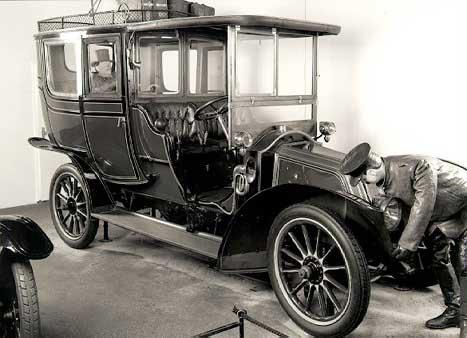
Popularization taxis in France contributed to this historical fact. During the First World War, the fall of 1914, German troops broke through the treacherous throw French defense and went to Paris. It was necessary to urgently push them towards reserves, but vehicles are not enough. And then there were "mobilized and called upon" the Parisian taxi. For one night about 1200 taxis were transferred to the line of the Marne River more than 6,500 soldiers. The enemy was stopped and the machine went down in history under the name "Marne taxis". On them they said: "If the geese saved Rome, that saved Paris taxis." Figurines Marne taxis were once produced millions of copies of their paintings adorn oilcloth table, beer mugs, ashtrays, pencil sharpeners; the car was devoted to a special stamp, which has become a rarity today.

Since 1905 taxi-boom began in the world. Taxis flooded streets of major cities in Europe and America. In each country, in this case as a taxi used different brands of vehicles - taxis various countries differed in appearance, color, acquiring a style associated with national culture.

While in France the prototype motorized taxi steel horse fiacres, in the UK one of the most popular in London taxis during the quarter of a century (until 1932) was a cab brand «Unic» (incidentally, the French production), in appearance and style also kept a lot in common with horse kebami.
The history of modern London taxi goes to the distant 1958, it was then that was born the famous Austin FX4, which today can be seen on the streets of London. This car eventually became the personification of the whole world of English taxi. Legendary car 39 years off the production line in different versions, only one engine was installed on the FX4 seven! Manufacturers FX4 - cooperate Austin, Mann and Overton acknowledged that the model is not without drawbacks. But renovation lineup did not happen due to lack of financial reserves for the development and production of a new cab. Carbodies company in 1982 bought the FX4 production and collected this model under the brand LTI (London Taxis International) until 1997. Updated modification FX4 was named Fairway. Engines and transmissions for her had a stamp of Nissan. In all there were more than 75 000 FX-4, such a taxi today account for about 80% of the cabs of the United Kingdom.
It is worth mentioning one more manufacturer of cabs - Winchester Automobiles. From 1963 to 1972 the company produced vehicles taxi with a body made of composite materials. It subsequently used this technology company Metro-Cammell-Weymann, when created in 1987, its "glass fiber» Metrocab. It then went on to Moscow participants TV show "Taxi" on channel TNT.
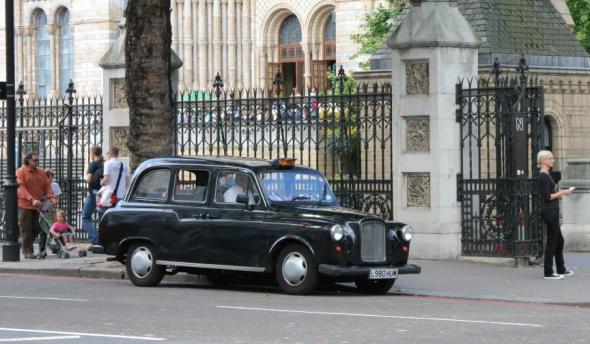
In the future LTI were created more modern models (see photo), the latest model TX4 (on the photo - the first). Specifications of the London Taxi as well as the level of comfort - not bad: 2, 5 liters. diesel, automatic transmission, ABS, ESP, etc.

English taxi - cars unusual in all respects. Lifetime provided by the manufacturer, - 10-12 years, mileage - 800000 km, and this despite the tough continuous operation. In reality, the British cabs go by millions of kilometers, many are more than 25 years.
The license for a private carting in London for four centuries gives police time - three years. To license attached numbered token, the car also gets a special license plate number and an indication of the number of passengers that he is entitled to be transported at a time. Also, the license entitles the customer to pick up on the street. Not all taxi companies have the opportunity - cheaper to obtain the right to organize taxi by phone. Such a cab would not stop if you vote on the road, because it is fraught with a large fine and loss of license.

To qualify for the carting is not enough to pay a lot of money, we must also endure a difficult exam on the London and its streets. Most of London's kebmenov know the city so well that and do not think the services of GPS-navigator - they are equipped with only 2-3% of London taxis.

Until the 80s of the last century all English taxis were black. Today, this tradition is gone. London taxi is not only painted in different colors, but do not hesitate to wear bright advertising boards.

The first taxi - cars yellow - on the American continent were in New York. The increase in the number of cars on the streets of the United States greatly helped the Mafia - that organized crime groups oversaw the majority of taxis and were interested in their growth. Also in America during Prohibition taxi especially loved gangsters-smugglers. There was no more reliable than a taxi transportation for banned alcohol. Police in no way suspected of taxi drivers and roomy car, more like a mini bus, meanwhile, transported hundreds of bottles of alcohol.
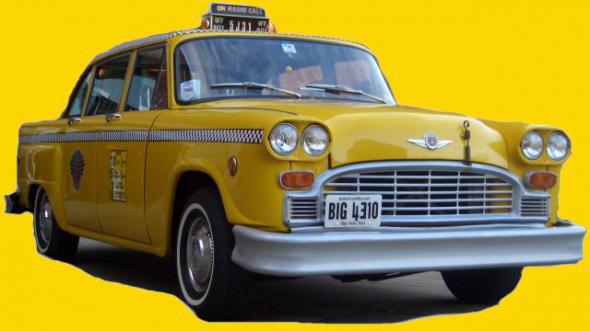
The first Russian car hired with the counter-taximeter was registered in St. Petersburg in 1906. In Moscow, the first taxi came on line 1 September 1907.
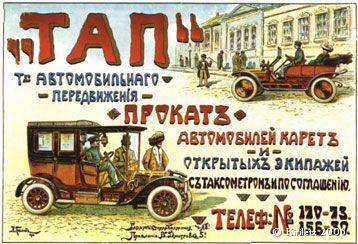
Since 1908 taxis appeared in all major Russian cities, provincial towns but taxi station is 30 cars. Only in the two capitals - St. Peterburi Moscow and passenger taxis were on a massive scale. Already in 1910 in St. Petersburg are on a 217 taxis, in 1911 they became 296 in 1912 - 380, in 1913 - 328, and by the summer of 1914 in the capital were registered 403 taxis. Taksomotory are in operation 30 different brands, dominated by low-cost but high-quality French cars «Charron» and German «Opel». In 1913, taxi transportation in St. Petersburg has been perfectly organized, there were numerous city taxi stand was set up a central dispatching service with the ability to call a taxi by phone, taxis worked around the clock.
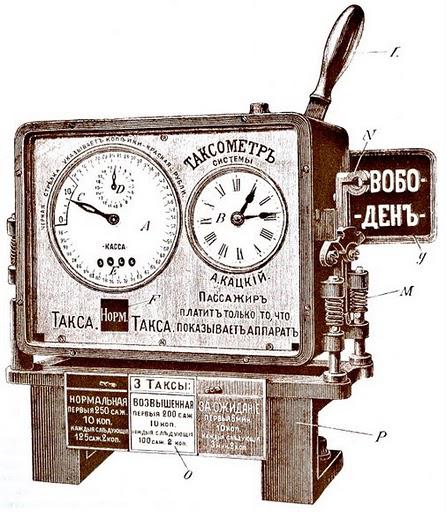
With the outbreak of World War II in 1914, a mobilization of the army as a driver, and suitable for the military service of vehicles, the number of taxis in the capital began to decline, by 1917 they had about 200 units.
via chubchik
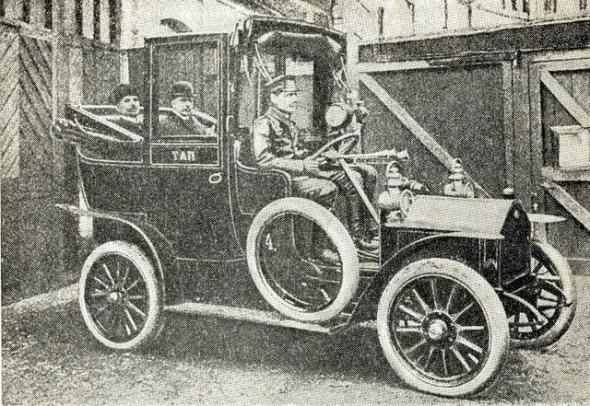
Source:
Both are right.
Passenger carting, as such, of course, originated in Britain (remember the famous London gig - cabs), France, meanwhile, became the founder of the modern taxi car, as it is here were laid to create a recognizable tradition and to this day the canons of this business.

The precursors of automobile taxi - horse-drawn carriages (cabs and fiacres)
So, the first organized paid transportation of passengers in the settlements began to be carried out in the UK in the XVII century. In 1639 the corporation was established kouchmenov license carting. First, the crews were quite bulky, and four open - they were called Hackney (hackney - a traveling horse). In winter, some particularly careful driver pulled over tilt carts.

In the middle of the eighteenth century, the private carting appeared in France, where some enterprising Frenchman founded inn horse-drawn carriages. Almost all of these carts had a closed body, and equipped with three rows of seats, where passengers are arranged facing each other (sometimes - in the direction of motion) and on a separate front seat sat the driver. Such carts - fiacres - became the world's first many-hired public crews. Prior to this in Europe capacious carriages belonged only to the nobles and landowners.
In the XIX century (1840-1845 gg.), London introduced into use more agile two-wheeled open carriage - convertible, abbreviated - cab. Subsequently, there were two and three cabs with a closed cab, and the driver's workplace has moved backwards and upwards, where it was easier to see the house numbers when there reigned the famous English fog. The British are known for their traditionalism, abandoned horse-drawn carriages - cabs, only in the middle of the XX century. Of course, a taxi car had already been actively developed in the UK, but in London the last horse cabby had surrendered his license only in 1947.

Beginning era taxis
In 1896, the French automobile club has proclaimed that the "capital of the world" would be very to face motorized fiacres - without horses. It Said - done: with Fiacre removed shafts, have established behind the petrol engine and near the driver's seat - the steering column and steering gear. At first, the idea was not successful, because they could not decide which tariff to pay travel and work drivers, and the piece made machines were expensive. Invented in 1905 by Count - taximeter - to a certain extent calmed disputes. From it came the name of the new mode of transport - taxis or taxi.

The company «Renault» became the first to mass-produce vehicles specially adapted to the taxi service. Painted in red and bright green, they stood out among the others, the majority of the black car, it was easy to recognize in the flow of traffic. A special device was a body. It was like a closed passenger compartment coach Fiacre, and the driver, like the driver, sitting in front of the public. It was believed that the driver must be separated from the passengers for their convenience and have complete freedom of view and communicate with pedestrians, driver, police and other drivers. And that is true, why the driver to hear the conversations of their passengers, and passengers - his quarrel in the crush of the crowded cars and horse-drawn carts streets. The device is affected and taxi drivers face, the shape of which was already different kind. They were dressed in a trench coat tightly buttoned leather and military-style cap.

Popularization taxis in France contributed to this historical fact. During the First World War, the fall of 1914, German troops broke through the treacherous throw French defense and went to Paris. It was necessary to urgently push them towards reserves, but vehicles are not enough. And then there were "mobilized and called upon" the Parisian taxi. For one night about 1200 taxis were transferred to the line of the Marne River more than 6,500 soldiers. The enemy was stopped and the machine went down in history under the name "Marne taxis". On them they said: "If the geese saved Rome, that saved Paris taxis." Figurines Marne taxis were once produced millions of copies of their paintings adorn oilcloth table, beer mugs, ashtrays, pencil sharpeners; the car was devoted to a special stamp, which has become a rarity today.

Since 1905 taxi-boom began in the world. Taxis flooded streets of major cities in Europe and America. In each country, in this case as a taxi used different brands of vehicles - taxis various countries differed in appearance, color, acquiring a style associated with national culture.

While in France the prototype motorized taxi steel horse fiacres, in the UK one of the most popular in London taxis during the quarter of a century (until 1932) was a cab brand «Unic» (incidentally, the French production), in appearance and style also kept a lot in common with horse kebami.
The history of modern London taxi goes to the distant 1958, it was then that was born the famous Austin FX4, which today can be seen on the streets of London. This car eventually became the personification of the whole world of English taxi. Legendary car 39 years off the production line in different versions, only one engine was installed on the FX4 seven! Manufacturers FX4 - cooperate Austin, Mann and Overton acknowledged that the model is not without drawbacks. But renovation lineup did not happen due to lack of financial reserves for the development and production of a new cab. Carbodies company in 1982 bought the FX4 production and collected this model under the brand LTI (London Taxis International) until 1997. Updated modification FX4 was named Fairway. Engines and transmissions for her had a stamp of Nissan. In all there were more than 75 000 FX-4, such a taxi today account for about 80% of the cabs of the United Kingdom.
It is worth mentioning one more manufacturer of cabs - Winchester Automobiles. From 1963 to 1972 the company produced vehicles taxi with a body made of composite materials. It subsequently used this technology company Metro-Cammell-Weymann, when created in 1987, its "glass fiber» Metrocab. It then went on to Moscow participants TV show "Taxi" on channel TNT.

In the future LTI were created more modern models (see photo), the latest model TX4 (on the photo - the first). Specifications of the London Taxi as well as the level of comfort - not bad: 2, 5 liters. diesel, automatic transmission, ABS, ESP, etc.

English taxi - cars unusual in all respects. Lifetime provided by the manufacturer, - 10-12 years, mileage - 800000 km, and this despite the tough continuous operation. In reality, the British cabs go by millions of kilometers, many are more than 25 years.
The license for a private carting in London for four centuries gives police time - three years. To license attached numbered token, the car also gets a special license plate number and an indication of the number of passengers that he is entitled to be transported at a time. Also, the license entitles the customer to pick up on the street. Not all taxi companies have the opportunity - cheaper to obtain the right to organize taxi by phone. Such a cab would not stop if you vote on the road, because it is fraught with a large fine and loss of license.

To qualify for the carting is not enough to pay a lot of money, we must also endure a difficult exam on the London and its streets. Most of London's kebmenov know the city so well that and do not think the services of GPS-navigator - they are equipped with only 2-3% of London taxis.

Until the 80s of the last century all English taxis were black. Today, this tradition is gone. London taxi is not only painted in different colors, but do not hesitate to wear bright advertising boards.

The first taxi - cars yellow - on the American continent were in New York. The increase in the number of cars on the streets of the United States greatly helped the Mafia - that organized crime groups oversaw the majority of taxis and were interested in their growth. Also in America during Prohibition taxi especially loved gangsters-smugglers. There was no more reliable than a taxi transportation for banned alcohol. Police in no way suspected of taxi drivers and roomy car, more like a mini bus, meanwhile, transported hundreds of bottles of alcohol.

The first Russian car hired with the counter-taximeter was registered in St. Petersburg in 1906. In Moscow, the first taxi came on line 1 September 1907.

Since 1908 taxis appeared in all major Russian cities, provincial towns but taxi station is 30 cars. Only in the two capitals - St. Peterburi Moscow and passenger taxis were on a massive scale. Already in 1910 in St. Petersburg are on a 217 taxis, in 1911 they became 296 in 1912 - 380, in 1913 - 328, and by the summer of 1914 in the capital were registered 403 taxis. Taksomotory are in operation 30 different brands, dominated by low-cost but high-quality French cars «Charron» and German «Opel». In 1913, taxi transportation in St. Petersburg has been perfectly organized, there were numerous city taxi stand was set up a central dispatching service with the ability to call a taxi by phone, taxis worked around the clock.

With the outbreak of World War II in 1914, a mobilization of the army as a driver, and suitable for the military service of vehicles, the number of taxis in the capital began to decline, by 1917 they had about 200 units.
via chubchik

Source:



